When one thinks of the Galapagos Islands, Charles Darwin, the most famous visitor to ever visit the archipelago, surely comes to mind. Darwin visited the islands as a young naturalist aboard the Beagle in the 1800’s. His experiences and observations in the Galapagos led him to theorize about some of the most revolutionary scientific topics in modern times in his book titled the “Origin of the Species”
Darwin’s Letters & Manuscripts
Darwin’s legacy lives on today, and his writings are highly prized. On the 21st of September, 2015, some of his controversial letters and manuscripts were auctioned off in New York. All of his writings sold at the auction fetched several thousand dollars each, and one letter in particular sold for $197,000 !
Charles Darwin doubtlessly changed the world, and he made the Galapagos Islands famous in the process. When Darwin visited the Galapagos, few people knew about the islands. Today the archipelago is a world-renowned destination where visitors and step back in time and marvel at the same creatures that inspired Darwin to revolutionize the scientific school of thought.
When you visit the Galapagos Islands, you will see why they are so special. The fearless and bizarre creatures and otherworldly landscapes will inspire you to ponder the origins of the volcanic archipelago just like Darwin did. Follow in Darwin’s footsteps, and discover the islands that changed the world.
Charles Darwin
2009 will be a big year in the Galapagos Islands, as the people of the archipelago celebrate the 200th birthday of their most famous honorary resident, British naturalist Charles Darwin (1809-1882).
2009 coincidentally marks the 150th anniversary of the first publication of Darwin’s groundbreaking book, On the Origin of Species, which detailed his controversial Theory of Evolution. Darwin visited Galapagos in 1835 on board the HMS Beagle, a British survey ship.
He only spent a few weeks in the Islands that he would make famous, but his notes and specimens from that short visit made his later work possible.
Charles Darwin was still a young student in 1831 when the Beagle set sail. He was selected as naturalist mostly because Captain Robert FitzRoy wanted a gentleman companion on board the ship: as an officer and a nobleman, he could not fraternize with the crew.
The Beagle sailed to the west, eventually going all of the way around the world before returning to England in 1836. Young Darwin had the opportunity to see many places, including Tierra del Fuego, Australia and South Africa. His journey would give him a lifetime’s worth of samples and notes, more than enough to allow him to make a name for himself as one of England’s most distinguished naturalists.
The Beagle was in the Galapagos in September-October of 1835 and completed a very thorough survey, visiting all of the main islands either in the Beagle itself or by sending out smaller boats. Darwin was very active, going ashore whenever he could to take notes and collect specimens. He would eventually visit four of the islands: Isabela, San Cristóbal, Santiago and Floreana.
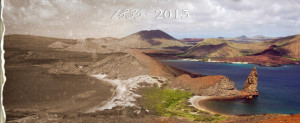
He was initially most interested by the different subspecies of mockingbirds to be found on the various islands, but he also collected other birds (including finches). Fortunately for Darwin, Captain FitzRoy was an amateur naturalist himself and he also collected specimens. Back in England, it was shown that FitzRoy had done a better job of labeling his specimens than Darwin had, and he allowed his old shipmate to study the animals he had collected.
While on the journey, Darwin began making a name for himself as a naturalist, as he corresponded with several important scientists in addition to his friends and family. He began developing his theories, usually thinking of the different mockingbirds he had seen.
He had also collected several fossils during his visit to South America. Upon return, he cemented his position by publishing his journals as The Voyage of the Beagle and began presenting papers at conferences.
He also married and tried to stay healthy: he had contacted a tropical disease while on his journey and it would torment him for the rest of his life.
He kept his most important work secret: the Theory of Evolution. He probably did so out of a combination of wanting to make sure no one else stole it and the knowledge that once revealed it would stir up a hornet’s nest with the Church. He toiled over his specimens, determining what made them different, and eventually realized that his finches made for a better illustration than the mockingbirds.
In 1858, he learned that another scholar, Alfred Russel Wallace, was preparing to give a paper on natural selection. Wallace, an old acquaintance, had contacted him, asking for an opinion on his work. Darwin did not want to have someone else get all of the credit, so they presented together. The next year, On the Origin of Species was published, describing the process of natural selection.
Darwin became an immediate, controversial celebrity. Many religious people were deeply offended, as they believed that God had created each and every creature as is, and that changes over time were impossible. The logical conclusion to take regarding humans and evolution was that mankind had evolved from some sort of ape, and this notion was cause for even more uproar.
Darwin himself stayed out of the fray, letting those who believed in his theories speak for him and defend his conclusions in public, although he followed the controversy closely from his home.
The controversy over his work did not end with his death in 1882: it continues to this day. Many people, particularly very religious ones, still find his conclusions offensive. In the past, the debate was always between Evolution (“Man evolved from other lower life forms”) and Creationism (“God made Man exactly as he is”).
Today, these two have been joined by a third, Intelligent Design. To make a long debate short, Intelligent Design is a sort of combination of the two (“God made evolution”).
Two hundred years later, the Galapagos is gearing up for a birthday party. The Charles Darwin Research Station will be hosting a major scientific symposium in Darwin’s honor, and many visitor ships are inviting guest speakers for special cruises aimed at those interested in Darwin and his life.
A Day in the Charles Darwin Life
The HMS Beagle, with a young Charles Darwin on board, only spent about five weeks in the Galapagos Islands, which seems short when you consider the importance the visit would have for Darwin, the Islands, and science in general. Darwin kept a journal, which he later expanded into a book, The Voyage of the Beagle, first published in 1837-1839.
In his book, Darwin writes at length about his stay in the islands and the interesting flora and fauna he observed, but he does not mention many specific days.
One day he does mention was September 29, 1835. The day before, they had turned the south-west corner of Albemarle (Isabela) Island and gone into the straight that separates Albemarle from Narborough (Fernandina), where they were becalmed for a time.
Darwin and his shipmates remarked on the black lava flows that covered both islands and noted that one of the volcanoes on Isabela was active, letting off a thin plume of smoke. They anchored in the sheltered Bank’s Bay, on the northwest corner of Isabela.
The next day, he went ashore on Isabela. He climbed one of the tuff cones and noticed a clear blue lake in the crater with a small island in the middle. “The day was overpoweringly hot, and the lake looked clear and blue: I hurried down the cindery slope, and, choked with dust, eagerly tasted the water-but, to my sorrow, I found it salt as brine.” This is now known as Beagle Lake.
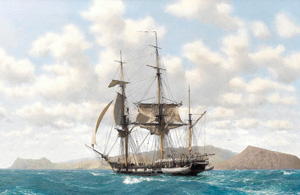
Darwin was fascinated by the reptiles he saw: “The rocks on the coast abounded with great black lizards, between three and four feet long; and on the hills, an ugly yellowish-brown species was equally common.” It was not his first encounter with marine and land iguanas, but their sheer number and size made quite an impression.
His observations of both iguana species were quite accurate. After dissecting several marine iguanas, he was able to determine that they feed on algae that grow underwater. He also studied their behavior, attempting to chase one into the water, to see if it would swim when endangered. Interestingly enough, he could not get one to go into the water to escape, leading him to deduce that even though they fed underwater, there were more predators there than on land.
Although he does not mention it in his entry for September 29, it is entirely probable that he collected samples of birds, reptiles and plants. He took home boxes of samples from the islands, including several species of mockingbird (which interested him the most at the time) and the finches which would later prove to be more interesting than the mockingbirds. The rest is history.
In the evening of September 29, it is probable that Darwin dined with Captain FitzRoy and the other officers on the Beagle. He generally dined with them when he wasn’t too seasick to eat, so it is probable that in the relatively calm Galapagos waters he was able to join them and trade stories about the day’s activities. Captain FitzRoy, an amateur naturalist himself, may have also collected birds that day.
Ironically, years later, it turned out that FitzRoy had been more diligent about correctly labeling his samples than Darwin! Darwin himself would certainly have gone to bed looking forward to another island visit the next day.
Charles Darwin Theory
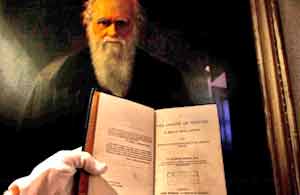
Charles Darwin theory On the Origin of Species overwhelmingly won with 26% of the votes, during a public vote on a list of the top 20 academic books in history compiled by academic booksellers, librarians, and publishers for Academic Book Week. The public has hailed his revolutionary book as the top book that changed the way we see the world.
The Origin of Species voted the most influential academic book in the world
Darwin’s book was up against works written by Plato, Einstein, Orwell, Shakespeare, Marx, and others. According to Professor Andrew Prescott of the University of Glasgow, Darwin’s book won the vote because it has, “changed the way we think about everything – not only the natural world, but religion, history and society.”
Charles Darwin’s voyage around the planet, and especially his time spent in the Galapagos Islands, inspired him to write his book which would go on to be the most influential academic book in history.
His observations, comparisons, and realizations based on his experiences have clearly changed the world in countless ways. Anyone who visits the unforgettable Galapagos Islands will understand why these otherworldly islands had such an impact on Darwin.
When you visit the Galapagos Islands, you can step back in time and marvel at the same wonders that fascinated Charles Darwin and led him to revolutionize the way we see our planet and its natural history. When you come face to face with the finches, mockingbirds, and giant tortoises in the Galapagos, you may wonder about the origin of species on Earth as well.
Come to the Galapagos Islands and ponder the secrets of life on the planet that inspired Charles Darwin to write the most influential academic book in history!
Galapagos & the Origin of Species
The name of Charles Darwin and his famous book the Origin of Species will forever be linked with the Galapagos Islands. Although he was only in the Galapagos for five weeks in 1835, it was the wildlife that he saw there that inspired him to develop his Theory of Evolution.
Today he is remembered in the Galapagos Islands with numerous statues, important streets named after him, and more than a few islanders named “Darwin.” But how much of Galapagos actually made it into his controversial book?
Darwin was Inspired in Galapagos
Galapagos Giant TortoiseIn Chapter Two of the Origin of Species, Darwin claims that it was his visit to the Galapagos that helped inspire his theories:
“Many years ago, when comparing, and seeing others compare, the birds from the separate islands of the Galapagos Archipelago, both one with another, and with those from the American mainland, I was much struck how entirely vague and arbitrary is the distinction between species and varieties.”
Endemism
The idea of endemic species – that is, species found only in one specific place and nowhere else on earth – was central to Darwin’s arguments. Here he once again used The Galapagos Archipelago and other islands to prove his point. He wrote:
“This fact might have been expected on my theory for, as already explained, species occasionally arriving after long intervals in a new and isolated district, and having to compete with new associates, will be eminently liable to modification, and will often produce groups of modified descendants.”
In other words, the endemic species that had evolved on remote islands proved his point as they adapted over long periods of time to a new environment, leaving behind their original characteristics.
Logical and Ecological
Darwin was increasingly frustrated with Creation Theory, which for him could not explain the presence of certain plants and animals in some places and not in others. The animals he found and did not find on the various islands led him to believe that his own theories of evolution were much closer to any sort of logical truth.
Here he discusses the lack of frogs on certain islands:
“This general absence of frogs, toads, and newts on so many oceanic islands cannot be accounted for by their physical conditions; indeed it seems that islands are peculiarly well fitted for these animals; for frogs have been introduced into Madeira, the Azores, and Mauritius, and have multiplied so as to become a nuisance. But as these animals and their spawn are known to be immediately killed by sea-water, on my view we can see that there would be great difficulty in their transportal across the sea, and therefore why they do not exist on any oceanic island. But why, on the theory of creation, they should not have been created there, it would be very difficult to explain.”
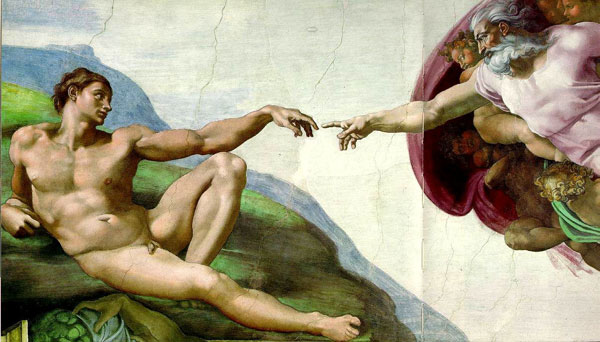
Darwin’s Finches
Surprisingly, Darwin does not dwell on his famous finches much in Origin of Species. His earlier journal, Voyage of the Beagle, however, shows the crucial role these finches played in his theories. He stated:
“The remaining land-birds form a most singular group of finches, related to each other in the structure of their beaks, short tails, form of body and plumage: there are thirteen species, which Mr. Gould has divided into four subgroups. All these species are peculiar to this archipelago; and so is the whole group, with the exception of one species of the sub-group Cactornis, lately brought from Bow Island, in the Low Archipelago.”
He later summarized his interpretation of the nature of these finches: “Seeing this gradation and diversity of structure in one small, intimately related group of birds, one might really fancy that from an original paucity of birds in this archipelago, one species had been taken and modified for different ends.”
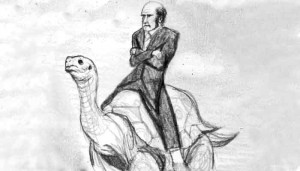
Darwin and the Galapagos
Reading Darwin’s works, it is easy to see the enormous impression that the Galapagos left on the young naturalist even though his visit was very brief. It was a mutually beneficial relationship!
The Islands provided Darwin the proof he needed for his groundbreaking theories, and in turn, Darwin provided the islands with a unique place in natural history, putting the remote islands “on the map”. Who can doubt that much of the current tourism boom in the islands is owed to Darwin and his once-radical theories?
Theories of Evolution:
Charles Darwin, the most famous of many visitors to the Galapagos Islands, is today remembered mainly for his Theory of Evolution. It’s important to remember, however, that Darwin was not the first one to suggest that animals changed over the course of generations to become more suited to their environment.
When Darwin visited the Galapagos Islands in 1835, the leading theory of evolution was that offered by Frenchman Jean-Baptiste Lamarck. His theory was called the Theory of Inheritance of Acquired Characteristics, and it had been around since 1801: eight years before Darwin was even born!
Lamarck’s Theory
Lamarck and Darwin agreed that animals change over time to adapt to their environment. For example, giraffe necks became longer over the course of thousands of years in order to allow them to eat leaves no other animal can reach. Lamarck believed that this was the result of changes which took place in individual animal lifetimes. Giraffes which stretched to reach food gave birth to offspring with longer necks.
Darwin’s Theory
Darwin’s 1859 publication of On the Origin of Species shows a fundamental difference with Lamarck. For Darwin, evolutionary change was random and had nothing to do with behavior. Darwin would have argued that some giraffes had long necks and some had short ones.
Over time, the long-necked ones ate better and therefore were more likely to pass their genes on to the next generation. The cause of the longer necks was random mutations, not repeated stretching by individual giraffes.
Darwin and Lamarck
Publicly, Darwin acknowledged Lamarck’s contributions to evolution, but privately he thought Lamarck’s theories were nonsense. Today, Darwin’s theories are accepted and Lamarck’s are not. Darwin’s theories conform to what is known about genetics and the logical problems of Lamarck’s theories are easy to see.
If a right-handed man loses the hand and spends a lifetime using his left, will his children be left-handed? Not necessarily.
Darwin in Galapagos
Charles Darwin must have seen much in Galapagos that caused him to distrust Lamarck’s theory. If the various finches and mockingbirds of Galapagos have longer necks or shorter legs than one another, that might be accounted for by Lamarck’s theories.
But the differences do not stop there: the different Galapagos species of these birds also have different beak shapes and sizes and their coloration is different. Lamarck’s theories cannot explain why one Galapagos finch is brown and another is black, because behavior cannot change the color of a bird!
Although his theory has been discredited, Lamarck is still an important historical scientific figure whose theories helped lay the groundwork for Darwin and other naturalists and scientists who came later. Maybe had Lamarck gone to Galapagos like Darwin did, it would be his name that is remembered!
For more information on Charles Darwin, see our links section.
- View the Galapagos Fast Facts
Charles Darwin Galapagos vs. Today’s Galapagos
Charles Darwin, an English naturalist and geologist, set out on a five year expedition on The Beagle in 1831. On his expedition he observed the rainforest in Brazil, discovered fossils and bones of extinct animals, experienced an earthquake in Chile, and finally landed on the Galapagos Islands in 1835.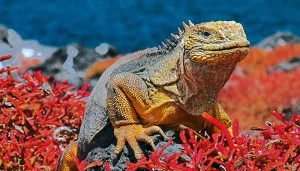
What Darwin observed on the islands contributed substantially to the formation of his theory of evolution.
When Darwin landed in the Galapagos Islands, he realized they were only recently inhabited. Just three years before Darwin’s arrival in the year 1832, General Jose Villamil from Ecuador founded a colony, and in the same year Colonel Ignacio Hernandez took over the islands and gave them Spanish names. Due to virtually no human settlement, Darwin was fortunate to observe the environment in its pristine, untouched state. He noted that mockingbirds resembling those in Chile, exhibited different traits from island to island. He also noted variations of the giant tortoise shell on each island.
Charles Darwin spent a mere six weeks on the islands, however, these six weeks proved to be enough for him to explore and observe the animals on the islands. The isolation of the islands allowed species to evolve and adapt to their surroundings. Darwin even noted particular adaptations to conditions of individual islands. He also observed how tame the animals were due to lack of predators. Darwin’s observations in the Galapagos provided the foundation for his theory of evolution.
Today one can still observe this rare behavior: animals on the islands living in harmony and not appearing disturbed by human presence. However, humans are present more than ever, inhabiting four of the islands with over 40,000 citizens and 170,000 visitors- last year alone. Imported species such as goats, ants, rats, cats, and dogs have adversely impacted the natural wildlife on the islands. The last tortoise of his kind, Lonesome George, was rightfully named as his giant tortoise sub-species became extinct upon his death in June of 2012. Although Lonesome George was successful in mating, the eggs did not survived long enough to hatch. George died a peaceful and natural death and was estimated to be over 100 years old.
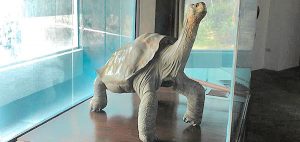
The land iguanas, finches, and tortoises still live in enough solitude to note their variations on each island. While the Galapagos Islands offer an amazing landscapes and an enchanting environment, human presence and introduced species have impacted the pristine, unique ecosystem of the islands. Many conservation efforts are being made to restore the Galapagos Islands’ pristine environment. Nevertheless, the fascinating quality of the islands that once enthralled Charles Darwin continues to enchant tourists and natives alike. There is no better time than today to come see what positive things are being done on the Galapagos Islands to keep this place amazing- for future generations and years to come.
If you would like to get more information about he Galapagos Islands history, please follow the next link: Galapagos Islands Natural History
| Our expert trip advisors will help you plan every detail of your Galapagos holiday. You can choose to visit the islands on a cruise and visit the remote and uninhabited islands as you step into an open air museum and scientific laboratory. Alternatively you can stay in a hotel on an inhabited island and take day trips in the archipelago. Either way, the wonders of the Galapagos will inspire you. Plan your expedition today! |
| Galapagos experts can help you plan your trip! Contact the experts (free trip planner) now at Galapagosislands.com for information about boats operating under the new itinerary. Or, sign up for our weekly newsletters to stay abreast of Galapagos news and to learn more about the islands. |
